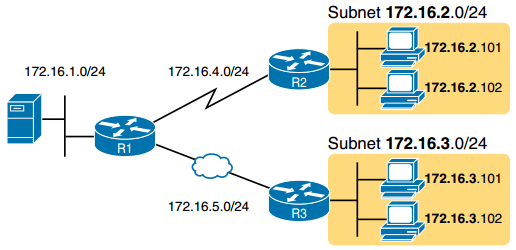CCNA DC FAQ: Anayzing Subnet Masks
 Figure: Simple Subnet Design, with Mask /24
Figure: Simple Subnet Design, with Mask /24
Q1. Which of the following answers lists the prefix (CIDR) format equivalent of 255.255.254.0?
a. /19
b. /20
c. /23
d. /24
e. /25
Q2. Which of the following answers lists the prefix (CIDR) format equivalent of 255.255.255.240?
a. /26
b. /28
c. /27
d. /30
e. /29
Q3. Which of the following answers lists the dotted-decimal notation (DDN) equivalent of /24?
a. 255.255.240.0
b. 255.255.252.0
c. 255.255.255.0
d. 255.255.255.192
e. 255.255.255.240
Q4. Which of the following answers lists the dotted-decimal notation (DDN) equivalent of /30?
a. 255.255.255.192
b. 255.255.255.252
c. 255.255.255.240
d. 255.255.254.0
e. 255.255.255.0
Q5. While working at the help desk, you receive a call and learn a user’s PC IP address and mask (10.55.66.77, mask 255.255.255.0). When thinking about this using classful logic, you determine the number of network (N), subnet (S), and host (H) bits. Which of the following is true in this case?
a. N=12
b. S=12
c. H=8
d. S=8
e. N=24
Q6. While working at the help desk, you receive a call and learn a user’s PC IP address and mask (192.168.9.1/27). When thinking about this using classful logic, you determine the number of network (N), subnet (S), and host (H) bits. Which of the following is true in this case?
a. N=24
b. S=24
c. H=8
d. H=7
Q7. An engineer is thinking about the following IP address and mask using classless IP addressing logic: 10.55.66.77, 255.255.255.0. Which of the following statements are true when using classless addressing logic? (Choose two.)
a. The network part’s size is 8 bits.
b. The prefix length is 24 bits.
c. The prefix length is 16 bits.
d. The host part’s size is 8 bits.
Q8. Which of the following statements is true about classless IP addressing?
a. It uses a 128-bit IP address.
b. It applies only to Class A and B networks.
c. It separates IP addresses into network, subnet, and host parts.
d. It ignores Class A, B, and C network rules.
Q9. Which of the following masks, when used as the only mask within a Class B network, would supply enough subnet bits to support 100 subnets? (Choose two.)
a. /24
b. 255.255.255.252
c. /20
d. 255.255.252.0